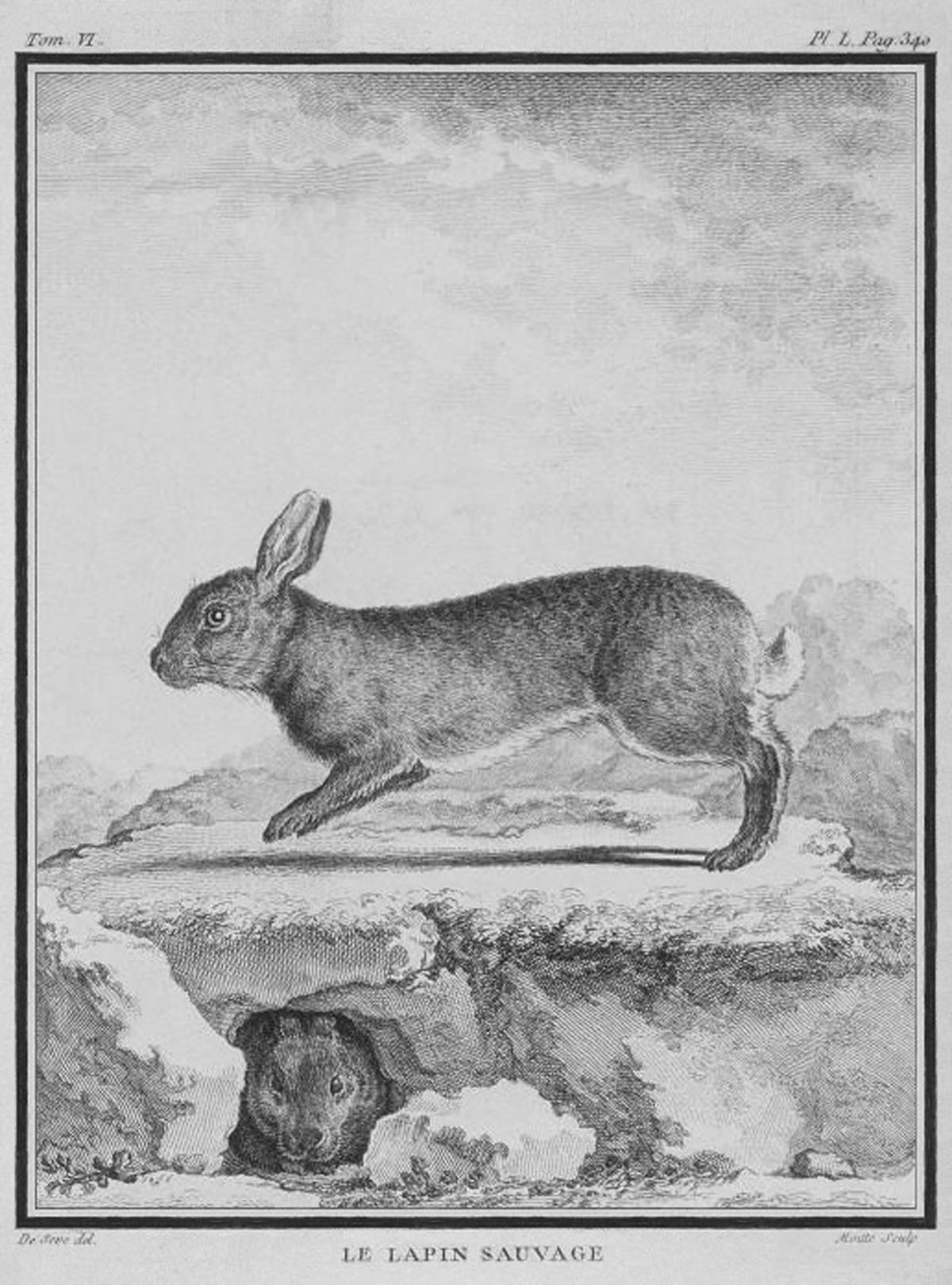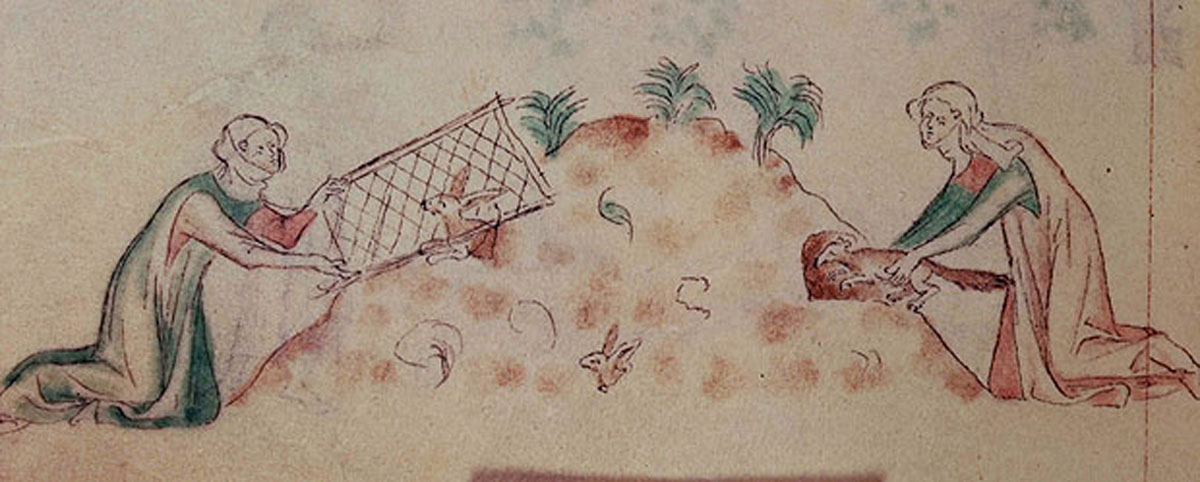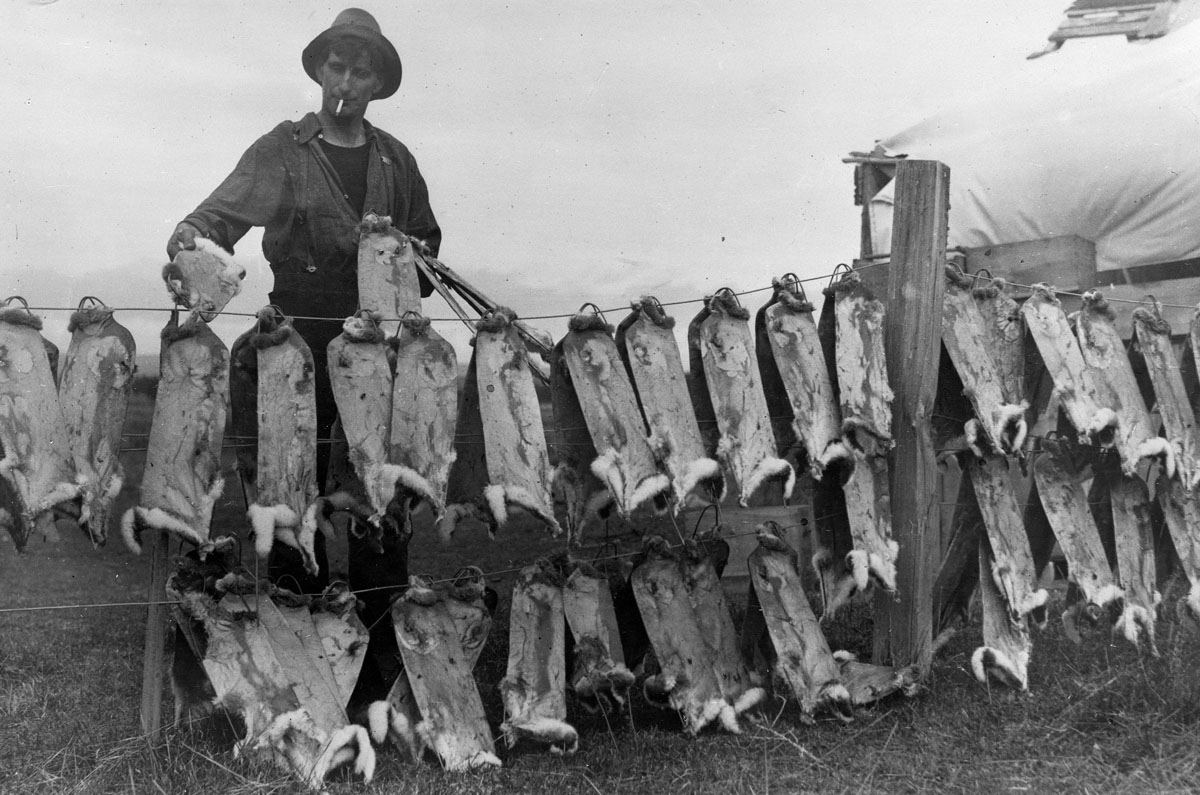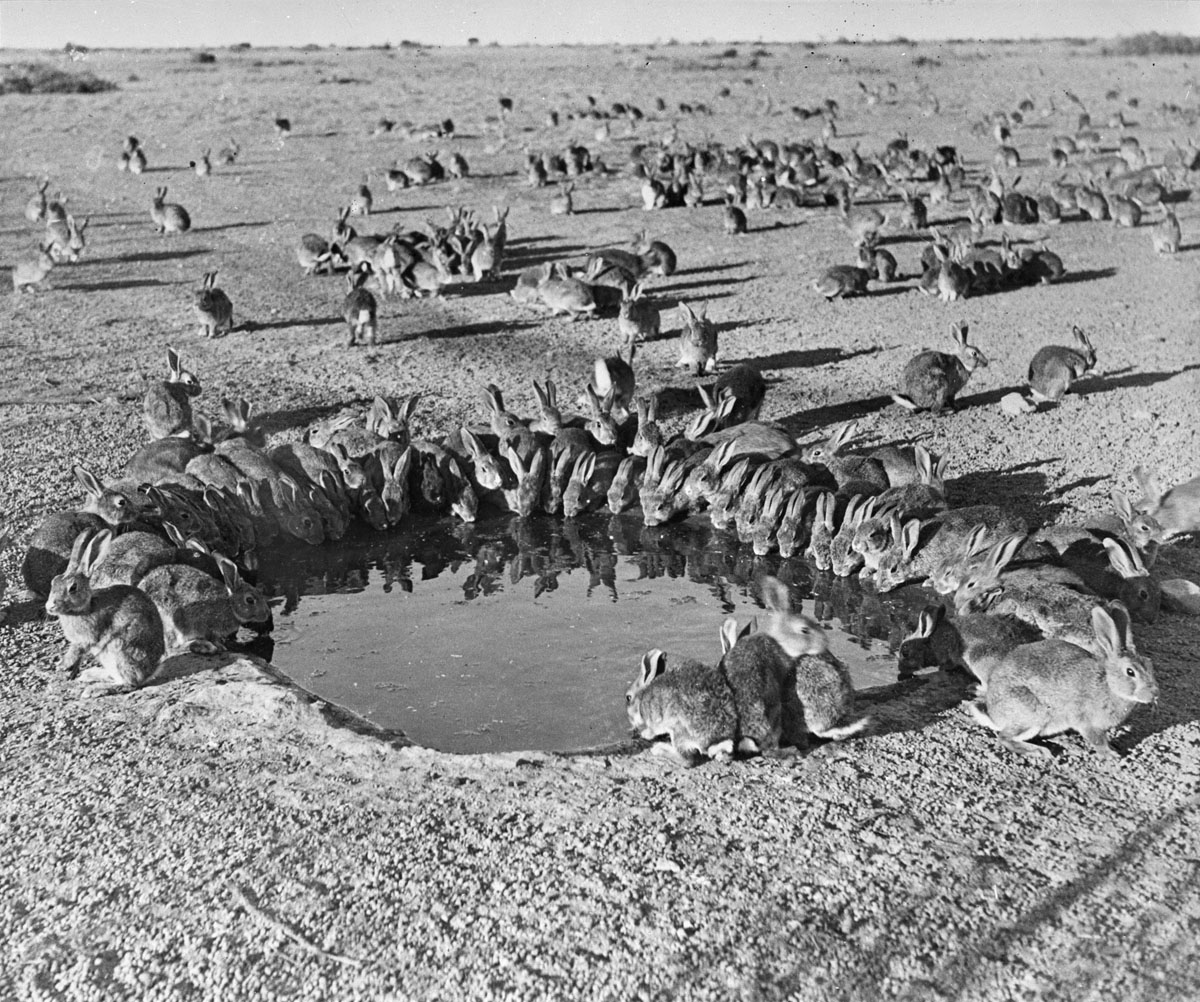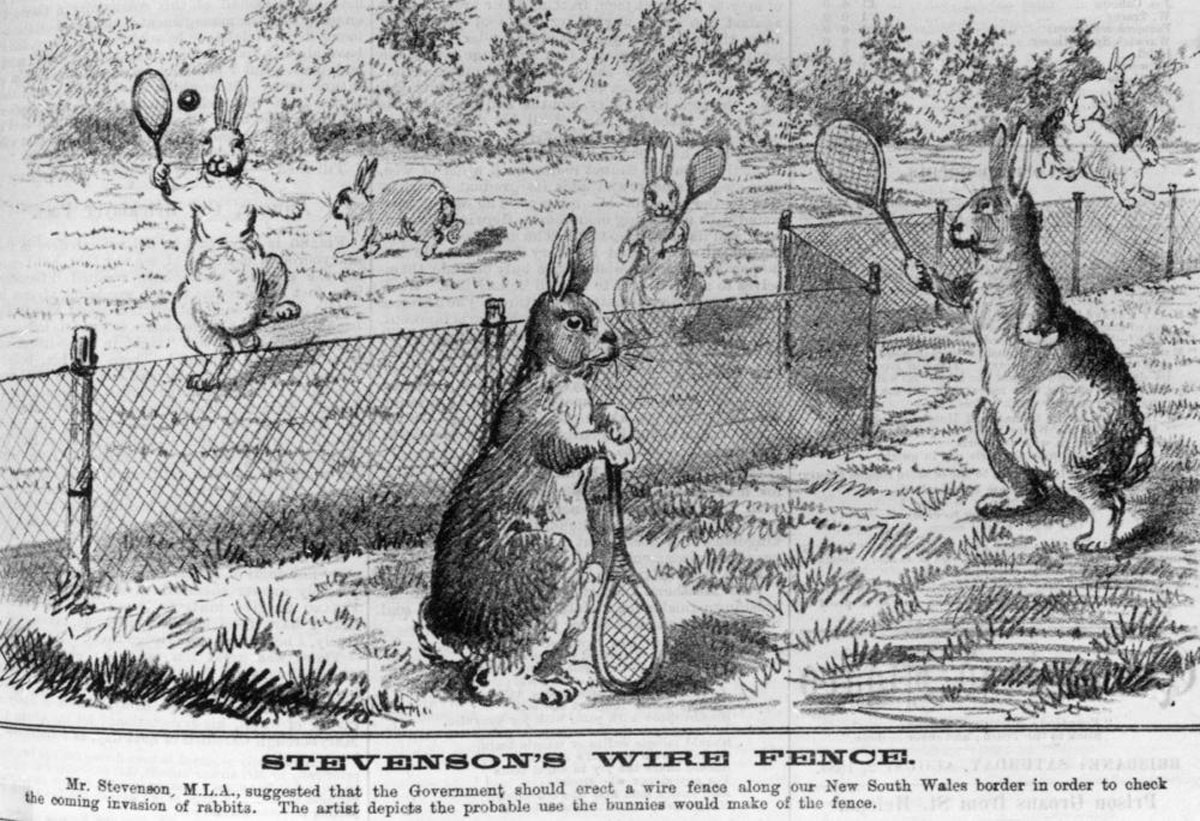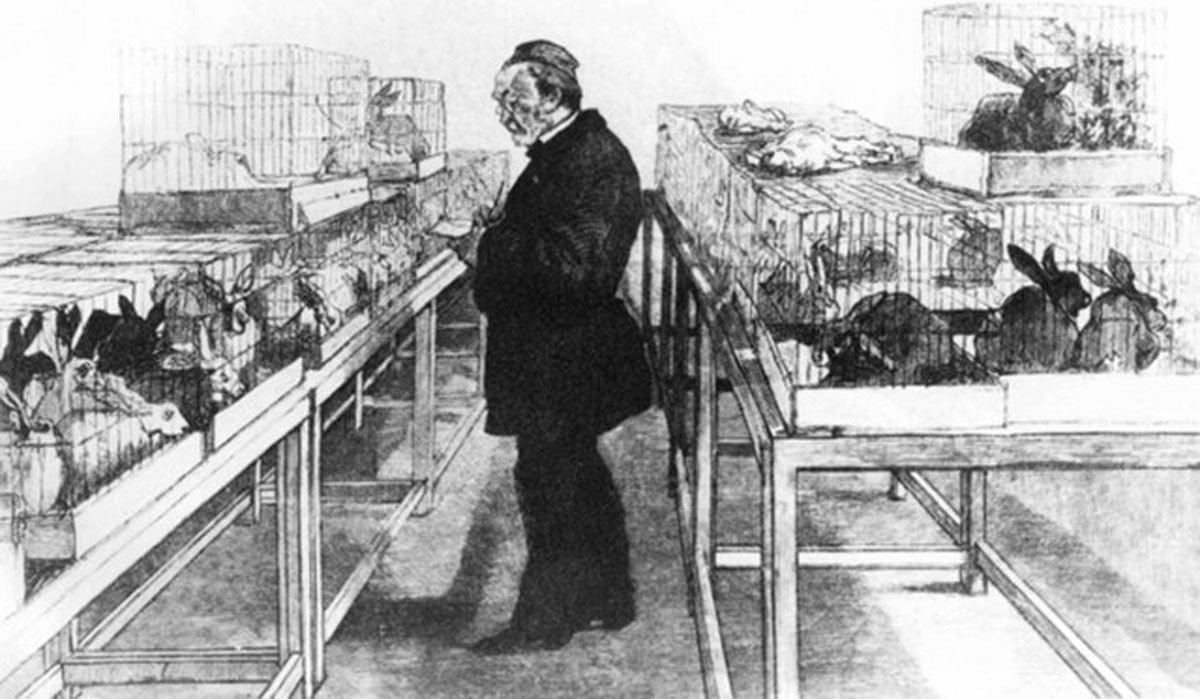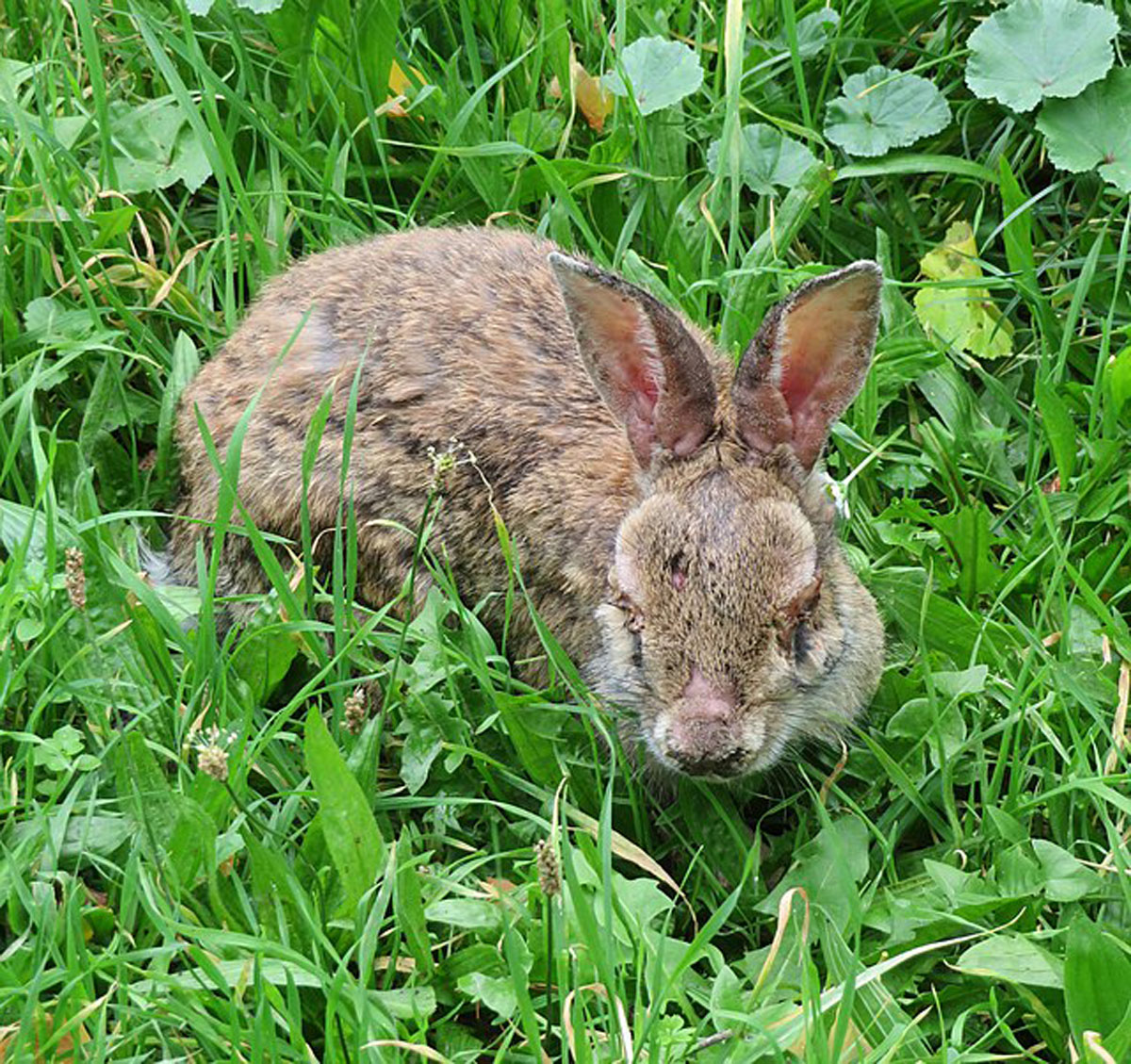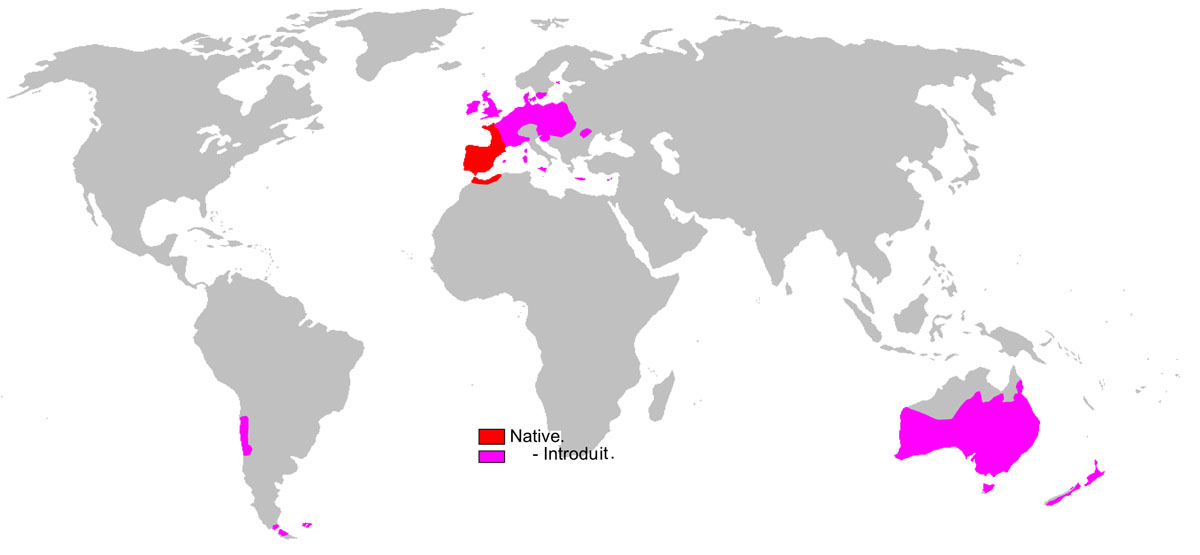Anna Tsing is suggesting an empathetic work that leads to a kind of tenderness. Empiricism is filled with tenderness. (Tsing & de Kerangal 2019)
Is Oryctolagus cuniculus (the Latin name for the European rabbit) a damn good trickster or an excellent teacher? He is a damn good trickster because he is always (at least) two things (or beings) at any one time, because he is not where we expect him to be, and because he resists when everything is grinding him down. But the rabbit is also a masterful teacher of crumpled (his)stories and broken geographies that both frighten us and make us laugh.
We begin with this small, long-eared animal (whose ears are shorter than those of a hare) with a grey-brown coat, paler on its belly, and a short white tail. And we begin with moors, forests, and fields of poor soils where the rabbit prefers to build its network of burrows. It is a rough start. Indeed, even his name in English immediately points to the ambivalence he produces. Wild? Referred to as a wild ‘warren rabbit’ (or simply ‘warren’), the animal is easily confused with the term applied to its habitat. Domestic? Originally, the ‘warren’ referred to a park for animal breeding in a more or less enclosed area.
As language is the ‘tools of tools’ (Dewey 1958), a change of meaning reveals a change in the symbolic and instrumental relationship. Is its mode of action on the real a starting point for any subsequent meaning (Steiner 2008)? From the outset, the linguistic ambivalence surrounding the naming of the rabbit introduces a mess that slices through shared terminology, goals, and situations. From the outset, a story emerges in which humans and other animals, plants, and soils interact in a particular environment—a nature that is reluctant to be taken as a single entity and instead is discovered through a multiplicity of converging and diverging trajectories that are constantly recomposed. ‘To listen and tell a rush of stories is a method. … Its research object is contaminated diversity; its unit of analysis is the indeterminate encounter. … A rush of stories cannot be neatly summed up’ (Tsing 2015: 37). Without a coherent or autonomous time or place, Anna Tsing’s approach became an evident fulfilment of the pragmatist movement that considers knowledge and experiences in essential and extraordinary interaction rather than in general terms (Debaise 2007).1
Rabbit: Wild and Domestic at the Same Time?
This question of whether the rabbit is wild or domestic haunted us from the start, as the first texts that describe the rabbit simultaneously present it as both one and the other. The animal comes into ‘real’ life, that is to say, in written text, in the first century before Christ or shortly after. According to Varro, a Roman scholar and magistrate (116–27 BCE), Appius Claudius Caecus (340–273 BCE) was the first to have described the rabbit. He writes about various animals that lived in the parks adjacent to the Roman villas: deer, wild boar, hare, and of course rabbits. The leporaria (in future referred to as ‘warrens’) are game parks surrounded by walls (to prevent cats, weasels, and wolves from entering) and planted with big trees (to keeps eagles out) and bushes (to provide shelter and food for the enclosed animals) (Varro 1934: III, 12). But Strabo (60 BCE–20 CE), a Greek geographer and historian, paints another picture. Pests, he writes, are rare in the south of the Iberian Peninsula, except for a particular species that buries itself in the earth and damages plants and trees by gnawing at their roots. A common occurrence in all of Iberia, it surpasses usual proportions and unleashes itself with the virulence of the plague, like that of snakes and rats (Strabo 2020: III, 2, 6). Such a calamity was also noted by Pliny the Elder, a Roman naturalist writer (23 BCE–79 CE). Strabo added that the inhabitants of the Balearic Islands, chased away from their homes by this destructive animal, asked Rome for new lands to be assigned to them. Pliny the Elder records that these inhabitants sought military help from the divine emperor Augustus to prevent the swarms of rabbits from spreading. The two writers both describe the presence of a ‘wild cat’ especially trained to predate the rabbits, reportedly imported by the Phoenicians, merchant sailors who sailed along the Spanish coast about 1000 years BCE.
We begin, therefore, with stories that evoke two modes of existence (Latour 2007; Souriau 1943) that are both named and acknowledged, as if they were ready to be used. These texts highlight the rabbit’s qualities as operating in the mode of ‘self-action: where things are viewed as acting under their own powers’ (Dewey & Bentley 1949: 108). The animal is prolific, homebound (well suited to domestication), and delicious (the Romans were keen on laurices, rabbit fetuses removed from the belly of a pregnant rabbit for human consumption), yet also ravenous (we will return later to their reliance on their two pairs of incisors and their classification as lagomorphs). ‘Self-action’ considers humans, animals, or things as organisms that have the capacity to initiate actions themselves. Herein lies the first level of attaining knowledge as addressed by Dewey and Bentley. Texts by Strabo, Varro, and other contemporaries concur that everything is defined by the characteristics of the being in question.
However, this first level of knowledge is difficult to conceive without considering relationships. The rabbit is immediately compared to and distinguished from its colleagues, other domesticable species and pests. One of the key players of its orchestrated predation, the ferret, would be unable to live independently. And humans, what about humans? What parts do they play in these narratives? Only between the lines do they reveal themselves to be male individuals, discoverers, collectors, sailors, farmers, hunters, food lovers, well-off, and armed or, in any case, heavily equipped. But Dewey and Bentley affirm that ‘self-action’ as the first logical degree of knowledge is after all archaic and leads immediately to the second degree: ‘inter-action: where things are balanced in relation to other things in causal interconnection’ (Dewey & Bentley 1949: 108). In any situation, the properties of one and the other are entangled. But how? The rest of the rabbit’s adventures are eccentric, almost incredible. Given the two starting points set by the ancient writers, their adventures can never be synthesised or separated.
A Homebody Animal?
The European rabbit reportedly came from Spain and southern France (Callou 2003). The homebody animal does not go far; he is lost a few hundred metres from the burrow and is afraid of water. How, then, is it currently present on all continents (except Antarctica) and on 800 island groups (Lees & Bell 2008)? Part of the answer lies in the role that warrens played. The semi-enclosed breeding systems that ensured a quick, easy, and inexpensive fencing in of this small animal. These practices were probably introduced around the 11th century BCE by the Phoenicians, who were also most likely responsible for the import of rabbits into the Mediterranean basin. Dissemination and domestication continued under the Romans and into the Middle Ages. The warrens that date back to the age of feudal law were the property of the lords and monks, to whom they were donated, and could not be expanded. But these parks were never hermeneutically sealed. The nobleman’s small game was constantly escaping. This inevitably led to conflicts (Lebas 2004), and this was how the rabbit got caught in a divisive social cleavage. The punishment for peasants who stole rabbits varied according to the historical period and place.
The warrens assign rabbits with a ‘residency’, but, paradoxically, the multiplication of these animal farms favoured the spread of this homebound species throughout Europe, particularly so in Britain, where its introduction was attributed to the Norman conquerors. The rabbit’s presence was confirmed from the 12th century onwards (Sheail 1971), but this was no easy enterprise because rabbits are not suited to humid climates; they resist, reproduce less, and die prematurely. It was only with a stubborn helping hand that the rabbit finally acclimatised to the British weather by growing thicker fur.
In Britain, as on the continent, the right to hunt and kill rabbits was a privilege granted by the king. Rabbit warrens were zealously guarded over by their owners. Quickly, however, the interest in rabbits was no longer limited to hunting them. While rabbit breeding was quite unlikely in Britain, it took an unexpected turn when it developed into a very lucrative fur trade. Rabbiting flourished until the end of the Middle Ages (Bailey 1998). Commercial exploitation of the rabbit warrens required sophisticated apparatus and careful management. The warreners, paid by their owners, inaugurated a lonely and marginal craft. Protecting rabbits included feeding them in the winter, trapping their natural predators (foxes, wild cats, ferrets, and weasels), and hunting down poachers. In autumn, they killed them (raising ferrets to do this) and collected their pelts. Rabbiting created surprising forms of interdependence. It was the intensive breeding of an exotic species that was protected at the cost of eradicating its native predators.
‘The more connections and interactions we discover, the more we know about the object in question’ (Dewey, cited in Steiner 2008: 276). Following the rabbit meant conducting an investigation that was not limited in time or space. This led us to fully enter the third level of interpretation, which was discussed by Dewey in his later work:
Transaction: where systems of description and naming are employed to deal with aspects and phases of action, without final attribution to ‘elements’ or other presumptively detachable or independent ‘entities’, ‘essences’, or ‘realities’ and without isolation of presumptively detachable ‘relations’ from such detachable ‘elements’. (Dewey & Bentley 1949: 108)
Settlers Cannot Do without the Rabbit
Until the end of the 16th century, the history of Oryctolagus cuniculus still seems to oscillate between intensive domestication and clandestine liberations. Over time, population numbers seem to follow a logical expansion rate, out from his place of origin, and continue to do so in a linear way across time. However, his subsequent adventures follow fragmented geography and not linear time. Rabbit breeding had to compete with the sale of more prestigious furs and new markets in Eastern Europe. This trend led to the end of commercial warrens. Rabbits were released into a patchwork of landscapes marked by deforestation, the development of unproductive areas, and the demarcation of fields, delimited by hedges. From the beginning of the 19th century, most of the territories of Western Europe were ‘infested’. Much of the damage, including overgrazing, crop destruction, and erosion, was attributed to rabbits, which were by now considered ‘pests’ (van Dam 2001).
The rabbit’s ecological success placed it among those species who multiply beyond human control. In France, at the end of the 18th century, rabbits were classified as a ‘nuisance’. ‘Warren rabbits’, long reserved for the nobility, became an ordinary dish, and hunting rabbits became highly popular, in part as a result of the proliferation of lightweight weapons. In England, the Ground Game Act of 1880 gave farmers the inalienable right to kill and sell rabbits, marking the end of commercial warrens (Sheail 1971). In the 1930s, the ban of the ‘gin trap’ (death trap) created a bristling divide between farmers and foresters on the one hand and hunters, consumers, and animal welfare associations on the other (Sheail 1991).
In the meantime, the warren rabbit surfed on the waves of colonisation. Oceania was most heavily affected by the warren rabbit’s voyages across the globe (Chapman & Flux 1990). English colonisers were scornful of the fauna they came across in Oceania (kangaroos, emus, and even the aboriginals) and wanted ‘their’ animals to indulge in the hobby they had recently acquired rights to in England. The English were very careful to distinguish themselves from the Aboriginal Australians who hunted ‘to survive’ (Olsen 2001).
Several attempts were needed to introduce the rabbit to Australia. The first attempts were made using domestic rabbits. In 1859, Thomas Austin imported 12 pairs of rabbits to Australia, wild and domestic. They did their best to adapt to their new environment and became the ancestors of several hundred million individuals. In New Zealand, too, a highly engineered introduction of rabbits took place (Flux 1997). Then, history accelerated in these two countries. Oryctolagus cuniculus took advantage of the lack of competitors, deforestation, and the recent cultivation of very large areas to occupy the territory at an unusually fast rate. The rabbit evolved to be smaller and more ferocious than in Europe, and its legendary sedentary lifestyle turned out to be relative—linked to the environment in which it evolved (Callou 2003). As soon as he arrived, the rabbit was hunted. While cats, foxes, ferrets, ermine, and weasels were introduced in order to pursue the rabbits, they did not contain them. Instead, they became heavily ‘entangled’ in the endeavour to kill them (van Dooren 2001).
At the beginning of the 20th century, settlers in Australia and New Zealand started to build a fence with the goal of separating farmed land from the bush. Several hundred horses and men were recruited, and an administration was set up to accomplish this difficult undertaking. In Australia, the fence stretched over 1,000 kilometres. Camels were even imported from Afghanistan to complete the heaviest work. Despite all these efforts, the fence was eventually thwarted by the unstable ground, termites, and shortages incurred by the First World War. The rabbit found new allies to demonstrate the failure of a project that was considered an inappropriate response to the threat rabbits posed. But all means of struggle used against him (gassing, poisoning, and of course hunting, snooping, and trapping) were also an opportunity for the settlers to assert their supremacy, if not also a way to ward off the fear of an apparently empty and unmanageable expanse (Olsen 2001).
Transaction is inquiry of a type in which existing descriptions of events are accepted only as tentative and preliminary, so that new descriptions of the aspects and phases of events, whether in widened or narrowed form, may freely be made at any and all stages of the inquiry. (Dewey & Bentley 1949: 122)
Tracing the rabbit uncovers trajectories that are constantly sketched out and movements that are deeply erratic. Nature is enterprising but also controlled by human projects, which are changing and limitless. As a result, encounters are unlikely. They evoke the ‘assemblages’ understood as multiplicities that change in nature as the forged connections increase (Deleuze & Guattari 1987). These are assemblages in which various trajectories are held together but where indeterminacy always prevails (Tsing 2015).
When Rabbits Enter the Making of Science
In the neo-Byzantine crypt where Louis Pasteur’s body rests, rabbit mosaics sing his glory. The laboratory animals (prolific and homebound) valiantly assisted the scientist in his major discoveries—notably, by having their spinal cords injected with rabies. And yet, when talking about the rabbit’s presence in Australia, Pasteur affirmed, ‘To destroy beings that multiply according to the laws of a frightening life progression, what use are mineral poisons? … Shouldn’t we rather use a poison that, like them, is endowed with life and capable of multiplying at astonishing rates?’ (Pasteur 1888: 88). Based on this intuition, Pasteur also experimented with the destruction of rabbits by inoculating them with chicken cholera in a basement. Encouraged by his success, he commissioned his nephew, Adrien Loir, to broadcast this discovery. But in Australia, Adrien Loir was eventually asked to refrain from any intervention (Pasteur 1888).
Whatever humans invent. Credit: Stevenson’s wire fence. Cartoon in response to Mr Stevenson’s (M.L.A.) suggestion for the erection of a rabbit fence between New South Wales and Queensland to check the invasion of rabbits. Queensland figaro and punch, State Library Queensland, Australia. Wikimedia Commons.
By the end of the 19th and beginning of the 20th century, applied ecology gained importance. Today, this discipline is generally associated with a critique of growth, but in its early years, it was closely linked to economic issues. In 1905, the Bureau of Biological Survey was created in the United States. It specialised in the destruction of ‘wild’ and ‘harmful’ animals (the two terms seemed to be used interchangeably). In Australia, the Council for Science and Industry was founded in 1916 and quickly expanded to include research on agriculture and livestock, as well as contributing to the struggle for pest control. This organisation then became the Commonwealth Scientific and Industrial Research Organisation (CSIRO). In 1932, Charles Elton, considered the father of animal ecology, established the Bureau of Animal Populations in Cambridge, UK, with similar intentions. And in France, the Institut Pasteur focused on human health and equally, although less well known, also supported research into agricultural issues.
Meanwhile, in 1895, Giuseppe Sanarelli, a student of Pasteur, founded the Institute of Experimental Hygiene in Montevideo, Uruguay. He brought his own laboratory animals, but in 1896, he noticed they had caught a fatal virus. The natural reservoir of the virus (Sanarelli myxoma) was unveiled in 1942. The rabbits’ American cousins Sylvilagus brasiliensis and Sylvilagus floridanus were healthy carriers of the virus, but they dealt the European rabbit a devastating blow. The vested interest in rabbits and the journeys they went on brought them into a deadly encounter with a virus that propelled them to the heart of a scientific and agronomic debate globally. A ‘coincidence’ that emphasised the intertwining of the rabbit’s wild and domestic modes of existence.
As early as 1918, Henrique de Beaurepaire Aragão, a Brazilian researcher, suggested using myxomatosis as a biological control agent against rabbits. At the University of Melbourne, knowledge about the interactions between the virus and other species was considered insufficient. Nevertheless, the new Research Institute for Science and Industry insisted on introducing it in situ as soon as possible, even though rabbit meat producers were formally opposed. In the 1920s, Aragão experimented with the spread of the disease at test sites, but to no avail (Fenner & Ross 1994). At the same time, between 1934 and 1935, an Australian researcher in Cambridge conducted experiments. Further attempts were made in Wales in 1936 and 1937. Simultaneously, an experiment on a Danish island failed, as did another one in Sweden in 1938 (Siriez 1957). Outside the laboratory, the virus thus seemed difficult to instil ‘artificially’.
We now know that many factors can contribute to the spread of the disease: the presence of insect vectors, rain, winds, high temperatures, etc. Viruses are pulled, pushed, and upset by natural elements. They hesitate. Scientists hesitate too, pulled, pushed, thwarted by economic and social forces. But in the early 1950s, the rabbit version of disaster broke out. While the disease was still being tested in experimental sites in Australia, it spread outside the quarantine zone at an unexpected rate and caused up to 99% of mortality among rabbits. The Australia’s Bureau of Agricultural Economics quickly observed a significant rebound in agricultural productivity, which attracted the interest of British farmers eager to get rid of rabbits (Bartrip 2008).
French researchers at the Institut Pasteur also had the virus in their possession, but the devastating nature of the disease prevented them from testing it, even in a confined environment. However, Dr Armand-Delille, exasperated by the calamities of rabbits actively multiplying on his property, released two sick animals on his own accord. The virus spread devastatingly. Very quickly, and according to ‘poorly determined’ factors, the whole of France was invaded, and the erratic progression of myxomatosis throughout continental Europe could not hide the trade of sick rabbits for long (Rivé 1981).
On the other side of the Channel, many people also dreamt of a world without rabbits, and it is not surprising that in 1953 myxomatosis was identified in areas far apart from one another. Public actions were initiated, but in contradictory ways. On the one hand, they aimed at stopping the trafficking of sick animals by criminalising it. On the other hand, they hoped to ‘take advantage’ of the situation to get rid of rabbits permanently (Sheail 1991). Rabbits died at frightening rates, and in England, a real national drama unfolded (Bartrip 2008).
Prime Minister Churchill stood up against animal cruelty by publicly supporting the Royal Society for the Prevention of Cruelty to Animals, a very populist stance that the Minister of Agriculture and Fisheries and the Minister of Forestry strongly reproached him for. But this radical divide was not just based on words: while advocates of agriculture displaced sick rabbits, animal supporters spread specimens which, gradually, acquired immunity against the virus. Familiar with the rabbit from small breeding holds, they could not let the mass destruction of an animal pass, because, for them, ‘gentleness’ was the rabbit’s primary mode of existence. But the debate raged on and uncovered a new question about the ‘right’ way to inflict a ‘humane’ death on ‘wild’ animals (Kean 2002).
A tool or nature? The rabbit flea, Sylopsyllus cuniculi, was introduced to Australia in 1968 as a new vector for the disease (Cooke 2008). Its impact is hard to assess because a new pathogen emerged: the viral haemorrhagic disease (VHD) identified in China in 1984. This new virus also caused rapid death in rabbit populations. In Australia, while it was still subject to a confined experiment programme, infected animals were found at a long distance from the experimental site (Landström 2001). Very quickly, the flea was recognised as a legal control method combined with other methods that were already used. In Europe, only a passive spread of the virus seems to be responsible for its spread. And in New Zealand (where myxomatosis did not take hold), it was farmers, overwhelmed by the damage caused by the rabbit, that brought it in clandestinely, even though a public consultation had recently ruled against its introduction due to scientific uncertainties (O’Hara 2006). So, should these farmers be considered as bioterrorists or as individuals totally misunderstood by their fellow citizens?
For more than a century, the making of science seized both human and animal fates. Thus, the story of Oryctolagus cuniculus crosses decisively with the history of technosciences and applied ecology. The knowledge and interventions from both sides multiply (like rabbits). The linearity of the story is lost, and assemblages are composed in all directions and are impossible to summarise. At the heart of the concept of transaction lie two requirements: first, to take into account the vitality of relationships between organisms and their environments and, second, to consider knowledge as resulting from actions and relationships between ‘knowing subjects’ and their ‘known objects’ (Steiner 2010). And as Anna Tsing shows it, we shape our understanding of the world through the ways we tell stories.
When Researchers Quarrel with Each Other
Provided that we do not jump any steps, nothing should be easier to understand than the scientific objects, networks of researchers, their allies, their institutions, their tools, their styles, and, finally, their questions, says Bruno Latour. But it is only by studying controversial objects before they become facts that we can trace the construction of knowledge, he adds (Latour 2007: 11). What better teacher than Oryctolagus cuniculus? We plunge into the heart of these ‘hesitant, and bushy processes’, in which rabbits and researchers are entangled: ‘It is ironic that we are simultaneously neither able to conserve (in its native range) nor eliminate (in its introduced range) a species for which we know almost everything about its biology and natural history’ (Simberloff, cited in Lees & Bell 2008: 314). What is going on? Everything is simple or everything gets complicated, especially when it comes to avoiding well-established categories, by tracking frictions and focusing on possible silences to spark new (hi)stories.
In Western Europe, ‘warren rabbits’ have been recognised as pests in agriculture and forestry since the 19th century. Today, however, their population numbers are declining significantly. The rabbit held up well against myxomatosis, and it resisted against HDV; however, the impact of these viral diseases, combined with the nibbling away of the countryside, seems to be defeating the rebel. And it is now that we realise that the rabbit provides many ‘ecological’ services’! The absence of rabbits modifies the ecosystems in their native habitats, as well as in the north of Europe, where they were introduced (Lees & Bell 2008). Under quasi-experimental conditions, the myxomatosis episode showed how essential the rabbit really is (Thompson 1994). The fox, ermine, weasel, and owl all miss this ‘umbrella species’, and so does the Iberian lynx, on the verge of extinction (Ferrer & Negro 2004); the Bonelli’s eagle; the wild cat; the vulture; the royal kite; and the buzzard.
Researchers subsequently ask the crucial question: why is it so difficult for animals to re-establish themselves where they have always lived? (Letty et al. 2006). Hunters’ knowledge, tools, and habits are combined with modern scientific methods, genetic marking, and monitoring to try to answer this question. Empiricism and much trial and error come together in this mission, with no guarantee of success. Attempts to restock populations are not very effective, though it is difficult to measure or explain why. In the meantime, rabbit numbers decline. They have been declared living heritage by hunters and naturalists alike, who usually do not tend to agree.
Some French hunters seem to be in a hurry. They finance scientific research that produces recombinant vaccines (GMO) against myxomatosis and HDV (Darries-Vallier, Ausset & Besrest 2013). Is the vaccine the solution? Could the use of ‘living syringes’ (fleas) make the animals even more vulnerable? The researchers have also observed that rabbit populations thrive without vaccines and that habitat destruction is largely responsible for their decline (Narce et al. 2012). Some murmur that it is irresponsible to seek out sophisticated remedies ‘here’ that could trigger disasters ‘there’.
Indeed, in other parts of the world, the struggle against Oryctolagus cuniculus is still on the agenda, while ways to control the vertebrate pests continue to be explored (Saunders et al. 2010). Several ‘candidates’ are being studied with a view to extending biological control agents. The consequences of which could be equal to the damage inflicted by the invasive species. However, since the clandestine introduction of myxomatosis, many complications have undeniably emerged: for example, the cost of research, the uncertainty generated by these actions, the need for researchers to engage with the public, and ethical considerations (in particular the question of animal welfare)—in other words, the need for a multidisciplinary approach. But researchers also state that ‘the full panoply of management technologies should be borne in mind, as well as the fact that many invasive populations are successfully managed today that would have been considered hopeless cases a few decades ago’ (Simberloff 2014: 118).
HDV remains central in the debate. Although the illegal nature of its introduction is still widely criticised, its efficiency in reducing rabbit populations is undeniably acknowledged (Sanders et al. 2010). Still, it is recognised that its success varies greatly across different terrains and that some of its impacts have been totally unexpected. Today, it is also proven that some highly threatened species have increased in numbers since rabbit populations declined (Pedler et al. 2016). Researchers wonder, is this operation of biocontrol, which the agricultural industry would undeniably benefit from, preferable to the inevitably delicate and very costly programmes that aim to reintroduce endangered species?
‘Don’t judge species on their origins,’ reads an article published in Nature. ‘Conservationists should judge species introduced into new environments “on their environmental impacts” rather than whether they are natives’ (Cooke 2012: 279). The concept of a species has always been slippery (Tsing 2015) and that of an invasive species even more so. The debate is growing. Although at first sight the arguments from both sides diverge, the way they are constructed is striking. Some say a dynamic vision of nature is necessary because the interactions between species are impossible to predict. Not only can the negative impacts of some non-native species on ecosystems reduce over time, but non-native species can also provide valuable ecosystemic services, especially since they are more likely to survive in areas where climate and habitats change rapidly (Schlaepfer, Sax & Olden 2011). It takes time to detect the impacts of an introduced species. Some impacts are subtle and only come to light after intensive research (Simberloff 2014). The passing of time and the unpredictability of encounters (Lees & Bell 2008) justify a wait-and-see attitude for some and, for others, the necessity to react quickly, as promptly and cheaply as possible. The selected examples articulate thoughts entangled with theories but also with silences. For (Australian) opponents of the rabbit, the idea of accepting him as a participant in ‘new’ ecosystems is supported by ecologists who will always arrive ‘when the battle is over’ (Cooke 2012). And in the meantime, gently but firmly, Spanish naturalists have devised a plan to introduce the rabbit to the lynx as part of their plan to protect the species. Domestic rabbits are served to young lynxes, to provide them with nourishing diets, while wild rabbits are reserved for adult lynxes to help preserve their predator instincts (Cabezas-Díaz, Lozano & Virgós 2009).
There is no overarching point of view in these actions and debates. No coherent unity is to be found in nature’s capacities to act, which mix with human techniques and the rumours they raise. ‘Studying the structures and histories of such multispecies webs in a time of global environmental frenzy means thinking about the suspension of human life in more-than-human landscape histories in new methodological and transdisciplinary ways’ (Tsing, Mathews & Bubandt 2019: S187). Following the rabbit, we point to times and places that should never have met but are reconnected: crumpled histories and broken geographies.
The Strength of Weak Methods
If we watch a hunter with his gun go into a field where he sees a small animal already known to him by name as a rabbit, then, within the framework of half an hour and an acre of land, it is easy—and for immediate purposes satisfactory enough—to report the shooting that follows in an interactional form in which rabbit and hunter and gun enter as separates and come together by way of cause and effect. If, however, we take enough of the earth and enough thousands of years, and watch the identification of rabbit gradually taking place, arising first in the subnaming processes of gesture, cry, and attentive movement, wherein both rabbit and hunter participate, and continuing on various levels of description and naming, we shall soon see the transaction account as the one that best covers the ground. This will hold not only for the naming of hunter, but also for accounts of his history back into the pre-human and for his appliances and techniques. No one would be able successfully to speak of the hunter and the hunted as isolated with respect to hunting. Yet it is just as absurd to set up hunting as an event in isolation from the spatio-temporal connection of all the components. (Dewey & Bentley 1949: 141)
Thinking in terms of transactions refutes intrinsic or essential qualities. It paints worlds that are always open, provisional, and open to revision, both across time and space. Undoubtedly, the two authors did not know to what extent Oryctolagus cuniculus would come to illustrate their proposal. Undoubtedly, we have only partially adopted their perspective by simply trying to follow this modest animal that for a little more than two centuries has accompanied the Western man in his conquests and inventions. From ‘domestic’, the rabbit became a ‘plague’ and, in some western European regions, ‘heritage’. Selected for its qualities, even genetically modified in the laboratory, it is still capable of spontaneously evolving in new territories and new climates and continues to encounter new species intertwining with their destinies in ways that were never expected. Certain viruses are then seen as ‘useful’ rather than ‘invasive species’, and in the meantime, the rabbit resists; he is immune but also refuses to settle back where he used to prosper.
As a way of ‘being alive’ and a way of ‘understanding life’, the transactionist posture crucially challenges our way of relating to objects of knowledge and our ways of naming them without radical separation between that which is named and the naming (Dewey & Bentley 1949). There is no objectivity per se (Latour 2007) only chains of associations, names, experiences, uses, and knowledge. Oryctolagus cuniculus provides us with endless examples. Its ‘initial’ ambivalence of a domestic and yet always wild animal intrigued us. With 2,000 years between them, ancient writers from antiquity and contemporary biologists agree on identifying and establishing the rabbit as a pest. Some appeal to the ferret, Caesar’s legionaries, or Emperor Augustus’s compassion, while others place bets on the rabbit’s encounter with viruses. Invisible, the virus is nevertheless deadly for the rabbit and could be even more fatal if genetically modified.
Knowledge, actions, and the inevitabilities that they evoke flow like streams. Some dry up, and others become rivers. An example is the widely established myth that gave the Iberian nation its name:
The Phoenicians, travelling from the eastern Mediterranean, discovered it [the rabbit] when they landed on the Iberian Peninsula. They confused it with the rock hyrax (Procavia capensis), a small mammal of the order Hyracoidea, which is present in Africa as well as also in the Near East. The Phoenicians named this new land the ‘country of the hyrax’ (I-Saphan-im), which evolved as Hispania (and later España or Spain in English). Although this scenario is difficult to confirm once and for all, nothing discovered to date rules it out. (Moutou & Pastoret, 2010: 100)
This plausible hypothesis (Hernández 2009) confirmed by virtuoso philologists, pulls time backwards and creates an unprecedented connection between rabbits that proliferate in their homeland and small mammals from the Middle East which resemble marmots. The hyraxes are described as ‘a people without power, yet capable of building their houses in the rocks’ (Proverbs 30:26). The Bible recognises them as belonging to the class of ‘four small but very wise animals’. And they multiply joyfully, as observed by the Phoenicians; ambitious pirates equipped with beautiful ships.
What about us then? Who are we to collect these fragments and point to such incongruous connections? Anna Tsing’s proposal (2015), to which we wholeheartedly subscribe, is to turn our backs on a world that denies the ability to ‘make stories’, to learn to tell the story of multiple-voice arrangements and their cascading consequences, and to refuse a priori to distinguish between what counts and what can be neglected. The accumulation of details unfolds in broken geographies and crumpled temporalities and makes present the multiple and entangled worlds that—with or without us—the living continue to fabricate with each other (Stengers 2022). They jostle each other without ever offering a definitive account and offer a ‘powerless’ method, which claims to follow—and survive in—the rock of worlds that share their wanderings and contradictions.
Notes
- Here we refer in particular to the text Knowing and the Known co-authored by Dewey and Bentley in 1949. We draw from it in extremely partial ways, but the surprising parallels to the trajectory of the European rabbit are very rewarding. ⮭
Competing Interests
The authors have no competing interests to declare.
References
1 Bailey, M. (1998). The Rabbit and the Medieval East Anglian Economy. Agricultural History Review, 36(1), 1–20.
2 Bartrip, P. W. J. (2008). Myxomatosis. A History of Pest Control and the Rabbit. London: Tauris Academic Studies. DOI: http://doi.org/10.5040/9780755622412
3 Cabezas-Díaz, S., Lozano, J., & Virgós, E. (2009). The Declines of the Wild Rabbit (Oryctolagus cuniculus) and the Iberian Lynx (Lynx pardinus) in Spain: Redirecting Conservation Efforts. In Aronoff, J. (Ed.) Handbook of Nature Conservation Global, Environmental and Economic (283–310). Hauppauge, New York: Nova Science Publishers.
4 Callou, C. (2003). De la garenne au clapier. Étude archéozoologique du lapin en Europe occidentale. Mémoires du Muséum national d’histoire naturelle, tome 189.
5 Chapman, J. A., & Flux, J. E. C. (1990). Rabbits, Hares and Pikas: Status Survey and Conservation Action Plan. Gland: IUCN.
6 Cooke, B. (2008). Managing the European Rabbit: Converging Interests between Australian Research for Rabbit Control and European Research for Their Conservation. In Alves, P. C., Ferrand, N., & Hackländer, K. (Eds.) Lagomorph Biology: Evolution, Ecology and Conservation (317–326). Berlin-Heidelberg: Springer-Verlag. DOI: http://doi.org/10.1007/978-3-540-72446-9_21
7 Cooke, B. D. (2012). Rabbits: Manageable Environmental Pests or Participants in New Australian Ecosystems? Wildlife Research, 39(4), 279–289. DOI: http://doi.org/10.1071/WR11166
8 Darries-Vallier, A., Ausset, A., & Besrest, P. (2013). Experimental Implantation Trials of Xenopsylla cunicularis Smit (Siphonaptera: Pulicidae) in Northern France with the Objective to Use It as Vaccine Vector. International Journal of Insect Science, 5, 21–34. DOI: http://doi.org/10.4137/IJIS.S11804
9 Debaise, D. (2007). Introduction. In Debaise, D. (Ed.) Vie et expérimentation: Peirce, James, Dewey (7–15). Mayenne: VRIN.
10 Deleuze, G., & Guattari, F. (1987). A Thousand Plateaus: Capitalism and Schizophrenia. Minneapolis, MN: University of Minnesota.
11 Dewey, J. (1958 [1929]). Experience and Nature. New York: Dover.
12 Dewey, J., & Bentley, A. (1949). Knowing and the Known. Boston: Beacon Press.
13 Fenner, F., & Ross, J. (1994). Mixomatosis. In Thompson, H. V., & King, M. C. (Eds.) The European Rabbit (205–240). Oxford: Oxford University Press.
14 Ferrer, M., & Negro, J. J. (2004). The Near Extinction of Two Large European Predators: Super Specialists Pay a Price. Conservation Biology, 12(2), 344–349. DOI: http://doi.org/10.1111/j.1523-1739.2004.00096.x
15 Flux, J. E. C. (1997). Status of Rabbits (Oryctolagus cuniculus) and Hares (Lepus europaeus) in New Zealand. Gibier Faune Sauvage, 14(3), 267–279.
16 Hernández, B. G. (2009). El origen de cuniculus (> conejo) y su difícil, pero legítima, relación con cunnus (> coño). Revista de Estudios Latinos (RELat), 9, 83–99.
17 Kean, H. (2002). Imaging Rabbits and Squirrels in the English Countryside. Society & Animals, 9(2), 163–174. DOI: http://doi.org/10.1163/156853001753639260
18 Landström, C. (2001). The Australian Rabbit Calicivirus Disease Program: A Story about Technoscience and Culture. Social Studies of Science, 31, 912–949. DOI: http://doi.org/10.1177/030631201031006005
19 Latour, B. (2007). A Textbook Case Revisited: Knowledge as Mode of Existence. In Hackett, E. J. et al. (Eds.) The Handbook of Science and Technology Studies, 3rd ed. (83–112). Cambridge, MA: MIT Press.
20 Lebas, F. (2004). Historique de la domestication et des méthodes d’élevage des lapins. Cuniculture. Available at: http://www.cuniculture.info/Docs/Elevage/Elevage-fichiers-pdf/Histoire-domestication.pdf
21 Lees, A., & Bell, D. (2008). A Conservation Paradox for the 21st Century: The European Wild Rabbit Oryctolagus cuniculus, an Invasive Alien and an Endangered Native Species. Mammal Review, 38(4), 304–320. DOI: http://doi.org/10.1111/j.1365-2907.2008.00116.x
22 Letty, J. et al. (2006). Repeuplements de lapins de garenne: enseignements des suivis par radiopistage. Faune Sauvage, 274, 76–88.
23 Moutou, F., & Pastoret, P.-P. (2010). Geographical Distribution of Domestic Animals: A Historical Perspective. Revue scientifique et technique, 29(1), 95–102. DOI: http://doi.org/10.20506/rst.29.1.1965
24 Narce, M., et al. (2012). Landscape Ecology and Wild Rabbit (Oryctolagus cuniculus) Habitat Modelling in the Mediterranean Region. Animal Biodiversity and Conservation, 35(2), 277–283. DOI: http://doi.org/10.32800/abc.2012.35.0277
25 O’Hara, P. (2006). The Illegal Introduction of Rabbit Haemorrhagic Disease Virus in New Zealand. Revue scientifique et technique, 25(1), 199–123. DOI: http://doi.org/10.20506/rst.25.1.1650
26 Olsen, D. (2001). Dividing Australia: The Story of Rabbit-Proof Fence. Things Magazine, 14, 25–39.
27 Pasteur, L. (1888). Sur la destructions des lapins en Australie et dans la Nouvelle-Zélande. Annales de l’Institut Pasteur, II, 8, 86–93.
28 Pedler, D., et al. (2016). Rabbit Biocontrol and Landscape-Scale Recovery of Threatened Desert Mammals. Conservation Biology, 30(4), 774–782. DOI: http://doi.org/10.1111/cobi.12684
29 Rivé, M. (1981). L’affaire de la myxomatose. Ethnozootechnie, 27, 37–44.
30 Saunders, G., et al. (2010). Modern Approaches for the Biological Control of Vertebrate Pests: An Australian Perspective. Biological Control, 52, 288–295. DOI: http://doi.org/10.1016/j.biocontrol.2009.06.014
31 Schlaepfer, M. A., Sax, D. F., & Olden, J. D. (2011). The Potential Conservation Value of Non-Native Species. Conservation Biology, 25(3), 428–437. DOI: http://doi.org/10.1111/j.1523-1739.2010.01646.x
32 Simberloff, D. (2014). Biological Invasions: What’s Worth Fighting and What Can Be Won? Ecological Engineering, 65(April), 112–121. DOI: http://doi.org/10.1016/j.ecoleng.2013.08.004
33 Siriez, H. (1957). La myxomatose, moyen de lutte biologique. Paris: SEP.
34 Sheail, J. (1971). Rabbits and Their History. Newton Abbot: David & Charles.
35 Sheail, J. (1991). The Management of an Animal Population: Changing Attitudes towards the Wild Rabbit in Britain. Journal of Environmental Management, 33(2), 189–203. DOI: http://doi.org/10.1016/S0301-4797(05)80095-7
36 Souriau, E. (1943). Les différents modes d’existence. Paris: PUF.
37 Steiner, P. (2008). Délocaliser les phénomènes mentaux: la philosophie de l’esprit de Dewey. Revue internationale de philosophie, 245(3), 273–292. DOI: http://doi.org/10.3917/rip.245.0273
38 Steiner, P. (2010). Interaction et transaction: quelques enjeux pragmatistes pour une conception relationnelle de l’organisme. Annales de la philosophie en process, 6, 203–213. DOI: http://doi.org/10.5840/chromatikon2010616
39 Stengers, I. (2022). Préface. In Tsing, A., Proliférations. Marseille: Éditions Wildproject.
40 Strabo. (2020). The Geography of Strabo: An English Translation, with Introduction and Notes. Translated by Duane W. Roller. Cambridge: Cambridge University Press.
41 Thompson, H. V. (1994). The Rabbit in Britain. In Thompson, H. V., & King, C. (Eds.) The European Rabbit: The History and Biology of a Successful Colonizer (64–107). Oxford: Oxford University Press.
42 Tsing, A. (2015). The Mushroom at the End of the World: On the Possibility of Life in Capitalist Ruins. Princeton, NJ: Princeton University Press. DOI: http://doi.org/10.1515/9781400873548
43 Tsing, A., & de Kerangal, M. (2019). Manufacture d’idées. Ecologie de l’attention—Dialogue entre Anna Tsing et Maylis de Kerangal, Hurigny, 29 mai 2019. DOI: https://lamanufacturedidees.org/edition-2019/#?2019-videos
44 Tsing, A., Mathews, A. S., & Bubandt, N. (2019). Patchy Anthropocene: Landscape Structure, Multispecies History, and the Retooling of Anthropology. An Introduction to Supplement 2, Current Anthropology, 60, S186–S197. DOI: http://doi.org/10.1086/703391
45 van Dam Petra, J. E. M. (2001). Status Loss Due to Ecological Success. Landscape Change and Spread of the Rabbit. Innovation, 14(2), 157–170. DOI: http://doi.org/10.1080/13511610125108
46 van Dooren, T. (2001). Invasive Species in Penguin Worlds: An Ethical Taxonomy of Killing for Conservation. Conservation & Society, 9(4), 286–298. DOI: http://doi.org/10.4103/0972-4923.92140
47 Varro, M. T. (1934). De Re Rusticae. Translated by W. D. Hooper and H. B. Ash. Chicago: University of Chicago Press.

